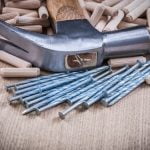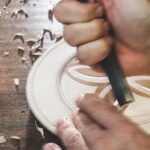Precision is an essential factor in any woodworking project. From crafting intricate furniture to building sturdy cabinets, the accuracy of measurements and angles can make or break the final result. One tool that plays a crucial role in achieving this precision is the set square. But what exactly is a set square used for in woodwork?
A set square, also known as a triangle or try square, is a simple yet versatile tool that every woodworker should have in their arsenal. It consists of two arms joined together at a right angle, forming a triangle shape. The purpose of this handy tool is to measure and mark precise angles during the construction process.
Why is precision so important in woodworking? Well, imagine if the angles on your cabinet doors were slightly off or if the legs of your table were not perfectly aligned – it would be quite noticeable and could affect the overall functionality of your piece. With a set square, you can ensure that each joint, cut, and angle is precisely measured and positioned, resulting in a professional-looking and structurally sound final product.
In this article, we will delve into the world of set squares, exploring their anatomy, functions, and various applications. We will provide step-by-step instructions on how to correctly use this indispensable tool and share useful tips for ensuring accuracy in your measurements. Additionally, we will discuss alternative uses for set squares beyond measuring angles and delve into different types available on the market along with tips for maintaining them properly.
By understanding the importance of precision in woodworking and familiarizing yourself with what a set square is used for and how to use it effectively, you can elevate your woodworking skills to new heights. So grab your timber and let’s embark on this journey together to unlock the true potential of your woodworking projects.
What is a set square
A set square is a fundamental tool in woodworking that is used for measuring and marking angles with precision. It consists of two arms, typically made of metal or plastic, joined at a 90-degree angle.
One arm is longer and is called the “blade” or “leg,” while the other arm is shorter and referred to as the “stock” or “heel.” The purpose of a set square is to provide accurate measurements and ensure that angles are correctly marked for woodworking projects.
The blade of a set square usually has graduations or markings along its length, allowing woodworkers to determine specific angles easily. These markings can be in degrees or inches and centimeters, depending on the design of the tool. Some set squares also come with additional features such as protractors or rulers on one or both arms to provide further functionality.
Set squares are available in various sizes, with common lengths ranging from 150 mm (6 inches) to 300 mm (12 inches). The smaller sizes are suitable for detailed work, while larger ones are more appropriate for larger-scale projects. Woodworkers often use multiple set squares of different sizes to accommodate various tasks.
When using a set square, it is crucial to ensure that it is accurately aligned before taking measurements or marking angles. Any slight deviation can result in imprecise measurements and affect the overall quality of the project. Therefore, it is essential to check if the edges of the blades are straight and if they meet at a perfect right angle.
Overall, a set square plays a vital role in achieving accuracy and precision in woodworking by providing reliable measurements for angles. It is an essential tool for woodworkers of all skill levels and should be included in every toolbox for those looking to achieve professional-quality results.
| Common Sizes | Features | Purpose |
|---|---|---|
| 150 mm (6 inches) | Graduations in degrees or inches and centimeters | Suitable for detailed work |
| 300 mm (12 inches) | Addition of protractors or rulers on one or both arms | Appropriate for larger-scale projects |
The anatomy of a set square
A set square is a versatile tool used in woodworking that helps in achieving accurate measurements and angles. To fully understand its functionality, it is important to delve into the anatomy of a set square and understand its different parts and features.
- Base: The base of a set square is typically made of durable material such as steel or clear acrylic. It is the flat surface that provides stability when positioning the tool against a workpiece.
- Blade: The blade is the longer side of the set square, usually ranging from 12 to 24 inches in length. It features precise markings along its edge, allowing for accurate measurements and angular calculations.
- Handle: The handle of a set square is an essential part that provides grip and control while using the tool. It is located at the perpendicular end of the blade, making it easier to hold and maneuver.
- Graduations: Set squares are often marked with graduations along their blades, indicating degrees or angles. These graduations aid woodworkers in measuring and marking angles accurately for various woodworking tasks.
- Right Angle: A set square is specifically designed with a right angle, forming a perfect 90-degree corner where the blade meets the base. This ensures precise right-angle measurements and helps in checking squareness during woodworking projects.
- Beveled Edge: Some set squares have one or both edges beveled, creating an angled cutting guide for tasks like marking dovetail angles or shaping chamfers on wood surfaces.
Understanding these different parts and features of a set square will enable woodworkers to effectively utilize this tool for accurate measurements and angle calculations in their woodworking projects. Combining proper technique with knowledge about each component will result in more precise outcomes and impeccable craftsmanship.
How to use a set square
Using a set square correctly is essential in order to achieve accurate measurements and angles in woodworking. Here is a step-by-step guide on how to use a set square effectively:
- Familiarize yourself with the different parts of a set square: A set square typically consists of two arms and one hypotenuse. The arms are usually perpendicular to each other, forming a right angle. The length of the arms varies depending on the size of the set square.
- Start by preparing your workpiece: Ensure that the surface you will be measuring or marking on is clean and smooth. Any imperfections may affect the accuracy of your measurements.
- Positioning the set square: Place one arm of the set square against the edge of your workpiece, aligning it with your desired angle or measurement. Hold it firmly in place.
- Marking with a pencil: Once you have positioned the set square correctly, take a pencil and mark along the edge of the other arm onto your workpiece. This will indicate where you want to make your cut or complete your measurement.
- Repeating for multiple angles or measurements: If you need to measure or mark multiple angles or lengths, simply reposition the set square accordingly and repeat steps 3 and 4.
- Checking for accuracy: After marking, double-check your measurements using a ruler or tape measure to ensure they are correct and aligned as desired.
By following these steps, you can effectively use a set square to achieve precise measurements and angles in woodworking projects.
Additional Tips:
- Always ensure that your set square is clean and free from debris before using it.
- If working on larger pieces, consider using clamps to secure both the workpiece and set square in place.
- If possible, invest in a high-quality set square made from durable materials such as stainless steel for better accuracy and longevity.
- Keep your set squares stored properly when not in use to prevent any damage or distortion to their shape.
Using a set square correctly is crucial in woodworking as it helps ensure accuracy and precision in measuring and marking angles. With the step-by-step guide provided, woodworkers can confidently use this tool to achieve the desired results in their projects.
Measuring and marking angles
Measuring and marking angles accurately is one of the primary functions of a set square in woodworking. Whether you are constructing furniture, building cabinets, or designing intricate woodwork, having precise measurements and angles is crucial for achieving professional results. In this section, we will delve deeper into the process of measuring and marking angles using a set square.
Understanding Angles
Before we can effectively use a set square to measure and mark angles, it is important to have a solid understanding of what angles are. In woodworking, an angle refers to the space between two intersecting lines or surfaces. Angles are commonly measured in degrees using tools such as protractors or set squares. The size of an angle determines how wide it is, with larger numbers indicating wider angles.
Using a Set Square to Measure Angles
To measure an angle using a set square, start by placing one edge of the tool against one of the intersecting lines or surfaces that form the angle. Then, rotate the tool until the other edge rests against the second line or surface. The point where these two edges meet on the scale of the set square indicates the measurement of the angle in degrees.
It is important to note that when measuring angles with a set square, accuracy is key. Ensure that both edges of the set square are aligned perfectly along each line or surface forming the angle before taking your measurement. Any misalignment can result in incorrect measurements and ultimately affect the overall alignment and symmetry of your woodworking project.
Marking Angles with a Set Square
Once you have successfully measured an angle using a set square, it is essential to mark it accurately on your material for further reference during cutting or shaping processes. To mark an angle on your material using a set square, carefully align one edge of the tool along one line or surface forming the angle. Hold it firmly in place to prevent any movement.
Then, use a pencil or marking knife to trace along the other edge of the set square. This will create a precise and clear marking on your material, indicating the angle you measured.
Ensuring accuracy
Calibrating the set square
One of the key factors in ensuring accuracy when using a set square is to properly calibrate it. Calibration involves checking if the angles on the set square are correct and accurate. To do this, you can use an angle measuring tool or a protractor to compare the angles marked on your set square with the actual measurements.
If you find any discrepancies, you can make adjustments by gently tapping the set square against a hard surface to align the angles correctly. Regular calibration of your set square will help maintain its accuracy over time.
Using a backer board
To ensure precise measurements while using a set square, it is important to have a stable surface for marking or cutting. This can be achieved by using a backer board. A backer board is typically a scrap piece of wood or any other solid material that is placed under your workpiece before making any markings or cuts. It helps prevent tear-out and provides stability, allowing for more accurate measurements with your set square.
Securing the set square
When using a set square, it is important to secure it firmly against your workpiece to avoid any movement or slippage that may lead to inaccurate measurements. Using clamps or holding down the set-square firmly with one hand can help ensure stability during measurement or marking processes. Additionally, maintaining consistent pressure while using the tool is crucial in achieving precise results.
Taking multiple measurements
To maximize accuracy when using a set square, it is best practice to take multiple measurements and compare them before finalizing any markings or cuts. This helps minimize errors caused by slight variations in technique or subtle movements during measurement. By taking several measurements from different points along your workpiece and averaging them out, you increase the reliability and precision of your final result.
By following these tips and techniques for ensuring accuracy, you can utilize a set square effectively in your woodworking projects. Remember that practice and experience are vital in mastering the use of this tool, so be patient and persistent. With time, you will develop a keen eye for precision and achieve outstanding results in your woodworking endeavors.
Alternative uses
A set square is primarily used in woodworking to measure and mark angles accurately. However, its functionality extends beyond just determining angles. There are several other instances where a set square can be useful in woodworking, providing versatility and precision in various tasks.
One alternative use of a set square is for checking the straightness of edges or surfaces. By placing the set square along an edge or surface, it can be used as a guide to ensure that it is perfectly straight. This is particularly helpful when working with boards or panels that need to fit together seamlessly.
Another use of a set square is for marking parallel lines. By aligning one side of the set square with an existing line, you can easily mark another parallel line next to it. This is especially handy when transferring measurements or creating multiple evenly spaced markings on a piece of wood.
Additionally, a set square can be used as a guide for making accurate crosscuts. By aligning one side of the set square with the edge of the wood and drawing a line along the other side, you can create a precise perpendicular cut. This ensures that your cuts are straight and at a perfect right angle.
Incorporating these alternative uses of a set square into your woodworking projects can greatly improve accuracy and efficiency. Whether it’s checking straightness, marking parallel lines, or making perpendicular cuts, utilizing a set square correctly will result in more professional and polished outcomes.
| Alternative Uses | Description |
|---|---|
| Straightness check | Placing the set square along an edge or surface to ensure it is perfectly straight. |
| Parallel line marking | Using the set square as a guide to mark another parallel line next to an existing line. |
| Precise crosscuts | Aligning the set square with the edge of the wood to create a precise perpendicular cut. |
Different types of set squares
Set squares come in different shapes and sizes, each designed for specific woodworking tasks. Understanding the different types of set squares and their specific applications can help woodworkers choose the right tool for their projects. Here are some commonly used set squares:
- Try square: A try square is perhaps the most basic type of set square. It consists of a long, straight blade called a stock, joined at a right angle by another shorter blade known as the tongue. Try squares are primarily used for checking and marking 90-degree angles or ensuring that corners are perfectly square.
- Mitre square: As the name suggests, a mitre square is used for measuring and marking angles other than 90 degrees, specifically those commonly found in mitre joints. It has graduations on both sides of the blade to help accurately measure angles ranging from 45 to 135 degrees.
- Bevel-edged square: Similar to try squares, bevel-edged squares also have a stock and tongue joined at a right angle. However, bevel-edged squares feature beveled edges along one or both sides of the blade. These beveled edges allow woodworkers to easily mark lines parallel or perpendicular to an edge.
- Combination square: Considered one of the most versatile set squares, combination squares combine features of multiple tools into one convenient device. They typically consist of a ruler-like blade that can slide along a headstock with a built-in level vial or protractor attachment for measuring and marking various angles accurately.
It is important to select the appropriate type of set square based on the task at hand to ensure precision in measurement and marking. By having different types available in their tool collection, woodworkers can tackle an array of woodworking projects with confidence knowing they have the right tool for each job.
Maintaining and caring for a set square
A set square is an essential tool in woodworking that helps ensure precision and accuracy in measuring angles. To keep your set square in optimal condition, it is important to practice proper maintenance and care. By following these essential tips, you can prolong the longevity of your set square and maintain its accuracy.
Firstly, it is crucial to keep your set square clean. After each use, remove any sawdust, debris, or other particles that may have accumulated on the tool. You can use a soft brush or cloth to gently wipe away any dirt. Avoid using harsh chemicals or abrasive materials as they can damage the surface of the set square.
Additionally, make sure to store your set square properly. Keep it in a dedicated storage area where it is protected from moisture and extreme temperatures. Consider using a protective case or sleeve to prevent any accidental bending or scratching of the tool.
Another important aspect of maintenance is checking the accuracy of your set square regularly. Over time, due to wear and tear or mishandling, a set square may become misaligned. To check if your set square is still accurate, place it against a known flat surface such as a piece of glass or metal plate. If there are gaps between the edges of the tool and the surface, it may need adjustment or replacement.
Lastly, remember to never use your set square as a hammer or leverage point. This can lead to breakage or deformation of the tool’s angles and edges. Treat your set square with care and handle it gently during use.
By following these tips for maintaining and caring for your set square, you can ensure its longevity while preserving its accuracy for precise woodworking measurements. Taking proper care of this valuable tool will contribute to better quality craftsmanship and successful woodworking projects overall.
Conclusion
In conclusion, a set square is an essential tool in woodwork, providing the user with precision and accuracy in measuring and marking angles. Its primary function is to assist in determining and creating precise angles, which is crucial for the overall quality and aesthetics of any woodworking project. By using a set square correctly, woodworkers can ensure that their cuts, joints, and measurements are accurate, leading to professional-looking results.
The practicality and significance of using a set square cannot be overstated. Whether you are a beginner or an experienced woodworker, incorporating this tool into your projects will greatly enhance the overall outcome. The set square allows for consistency in measurements, ensuring that all your angles remain true throughout your project. This level of precision can make a significant difference in the structural stability and visual appeal of your finished piece.
Additionally, by using a set square properly, you can save time and materials by avoiding mistakes or unnecessary adjustments. It is important to familiarize yourself with the different types of set squares available in the market so that you can select the one most suitable for your specific woodworking needs. Proper maintenance and care should also be prioritized to maximize the longevity of your set square.
Frequently Asked Questions
What is the purpose of a set square?
The purpose of a set square in woodworking is to accurately measure and mark angles. Set squares are triangular measuring tools with a right angle (90 degrees) on one corner, while the other two corners are usually 45 degrees.
They allow woodworkers to create precise and consistent angles when cutting or marking their workpieces. By aligning the set square against edges or surfaces, woodworkers can ensure that their measurements and markings are perpendicular or at specific angles, making their woodworking projects more accurate and professional-looking.
What are squares used for in woodworking?
Squares are an essential tool in woodworking and serve multiple purposes. One common use of squares is for checking and drawing right angles. Woodworkers often need to make sure that edges, corners, or joints meet at perfect right angles for stability and precision.
Squares help them achieve this by allowing them to quickly check the alignment of their workpieces or draw crisp perpendicular lines. Another use of squares is for laying out or transferring measurements onto wood pieces accurately. For example, when marking where to cut or drill holes, woodworkers can use squares to ensure precise placement and maintain symmetry in their projects.
What are the four 4 types of squares used in woodworking?
There are four main types of squares commonly used in woodworking: try square, framing square (also called carpenter’s square), combination square, and sliding T-bevel. A try square consists of a steel blade perpendicular to a wooden handle, forming an L-shape tool primarily used for checking right angles during layout and construction work. Framing squares have a longer body with a wider range of measurements engraved on them – they are versatile tools used for checking angles as well as making precise measurements during framing projects such as building walls or roofs.
Combination squares offer various functions in one tool – they typically have a ruler, level vial, protractor head, and scriber attachment for measuring, marking angles, leveling surfaces, and more. Lastly, sliding T-bevels consist of a handle connected to an adjustable blade that can be set to any desired angle, making them perfect for transferring and duplicating angles in woodworking.

Hi everyone! I’m a woodworker and blogger, and this is my woodworking blog. In my blog, I share tips and tricks for woodworkers of all skill levels, as well as project ideas that you can try yourself.





